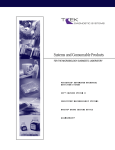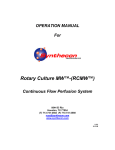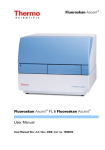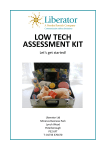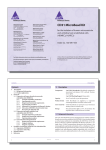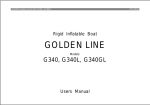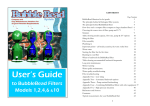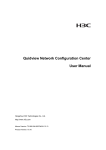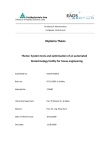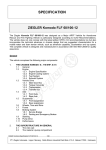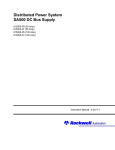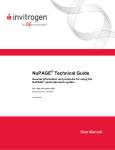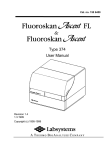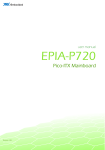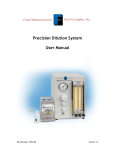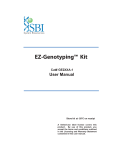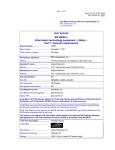Download Quasi-Vivo Systems Tools for Physiologically Relevant in vitro Cell
Transcript
The Sheffield Bioincubator 40 Leavygreave Road Sheffield S3 7RD Tel: 0114 213 1800 www.kirkstall.org Quasi-Vivo ® Systems Tools for Physiologically Relevant in vitro Cell Culture User Manual for QV500 Chamber System Issue Number 3.0 Table of Contents 1. Scope of the document 3 2. Introduction 3 3. Outline description of silicone cell culture chambers 5 4. Choosing a pump 6 5. General comments 7 6. Preparing the system for the first use 8 7. Preparation of cells 9 8. Opening and closing the chamber 11 9. Setting up an experiment 11 10. Flow rates 12 11. Calibrating the system 13 12. Disassembling the Quasi-Vivo® system 13 13. Cleaning the Quasi-Vivo® system 13 14. Sterilisation and cleaning procedures 14 15. Troubleshooting 14 16. FAQ 15 17. Glossary 16 2 1. Scope of the document This document describes the applications, setup and experimentation using the Quasi-Vivo® cell culture chamber system. It is aimed at users with basic tissue culture experience; enabling the transition between current static culture to perfusion culture techniques. This manual provides new users with guidelines to begin perfusion culture; the methods described may be adapted to suit the specific application. We advise that you read this document thoroughly before starting an experiment. For more information on tissue culture and sterile techniques we suggest you refer to: R. Ian Freshney, Culture of Animal cells, 2005. Please note that the current design enables the culture of any primary cell or cell line that grows as a monolayer. It is not currently designed for culture of cells in suspension. The system has been tested using human and rat primary hepatocytes, HepG2 (human liver carcinoma), C3A (human hepatoblastoma), NIH 3T3 (mouse embryonic fibroblast), adipocytes, NCI H292, HDMECs (Human Dermal Microvacular Endothelial Cells), HUVEC (human umbilical vein endothelial cells), human skin and oral fibroblasts, skin keratinocytes, osteoblasts and chondrocytes. These cells may be cultured on coverslips or scaffolds. Training courses demonstrating the assembly and use of the Quasi-Vivo® cell culture system are available, please contact us for more details. 2. Introduction The Kirkstall Quasi-Vivo® system has been developed in response to the need for small, inexpensive but reliable systems which can mimic the interactions between cells which occur in living organisms. The system enables quick and cost-efficient cytotoxicity testing and studies on metabolism with potential applications in the biotechnology, pharmaceutical, chemical, cosmetics and research industries. It allows the possibility of communication between different types of cells. This is achieved by a continuous flow of culture medium between the chambers. Figure 1 shows a flow chart explaining the practical implementation of the Quasi-Vivo® system. 3 Figure 1. Flow chart explaining the practical implementation of the Quasi-Vivo® system, and how it fits into current tissue culture protocol. 4 3. Outline description of silicone cell culture chambers The silicone chamber (figure 2) is the basic building block of the Quasi-Vivo® system. Quasi-Vivo® chambers are made of poly-dimethyl-siloxane (PDMS), a biocompatible silicone polymer. The ® external dimensions of Quasi-Vivo chambers are approximately 23 mm in height and extending to 37 mm in diameter. The internal volume of each chamber is approximately 2 ml and designed to accommodate 12 mm diameter coverslips. Figure 2. The Quasi-Vivo® chamber. Ethylene oxide gas-plasma sterilization is used to sterilise the chambers at the end of the manufacturing process. This is the most efficient method which maintains the unique properties of silicone; flexibility and breathability. The chambers are supplied double wrapped in sealed packs, each of which contains a colour-change indicator which turns from purple to green when the sterilization process is complete. Chambers can be re-used if washed with 70% ethanol and thoroughly rinsed with PBS after each experiment. The chambers are autoclave safe; however autoclaving more than 3 times is not recommended as the silicone will lose flexibility and become discoloured. Sterile silicone chambers are used for cell culture in non-therapeutic and non–diagnostic applications. Each chamber is made of two parts: an upper body and a base as shown in figure 3. 5 Figure 3. Illustration of the chamber’s component parts. Your Quasi-Vivo® system is delivered as a kit which includes: 3 silicone chambers with tubing and connectors 1 reservoir bottle 100 glass coverslips, 12 mm diameter A user manual 6 x 22 cm extension tubing with luer connectors We recommend the use of translucent polypropylene luer connectors, as supplied with the kit. Other connectors may be used but we found that the silicone tubing may slip and disconnect from the connector when placed in the incubator over 24 h incubation periods. Spare tubing and connectors can be supplied, as well as additional items such as holding trays; please contact Kirkstall for more information. 4. Choosing a pump The Quasi-Vivo® system must be connected to a peristaltic pump to enable perfusion of the chambers. Kirkstall is happy to provide advice and support in choosing the pump which will suit customers’ needs. Table 1 below shows examples of different types of pumps which can be provided by Kirkstall. See figure 4 for a demonstration of the system setup including the pump. 6 Pump Features Instech P720 Small and portable, ideal for small experiments. Not moisture – proof, can be used in dry, CO2 controlled incubator. Ismatec IPC/IP or /IPC- Medium size, multichannel pump (4- 24 channels) for multiple N/IP-N experiments, resistant to 80% humidity. Watson Marlow 520D Large, multichannel pump (4-32 channels), with IP66 enclosure which provides 100% resistance against humidity. Table 1. Descriptions of suitable pumps. Watson Marlow 520U Pump QV-500 Chamber Perspex Tray Filter Reservoir Bottle Figure 4. Quasi-Vivo® system setup connected to the Watson Marlow 520U peristaltic pump. 5. General comments All procedures which involve cell culture (seeding cells on coverslips, opening sterile chambers, opening and closing reservoir bottles, disconnecting and connecting the tubing) should be carried out in accordance with aseptic techniques. It is necessary to ensure that all cell culture procedures are performed to a standard that will prevent contamination from bacteria, fungi, mycoplasma and cross 7 contamination with other cell lines. All work should be done in a Class II tissue culture hood, wearing gloves and laboratory coats. After assembly the completed Quasi-Vivo® system can be transferred into a CO2 incubator and left for the duration of the experiment. 6. Preparing the system for the first use The reservoir bottle and chambers are supplied sterile and with the luer connectors attached. The extra luer connectors and tubing are not sterile. Initially the supplied luer connectors should be attached to the tubing in the required configuration; for consistency tube inlets should have female connectors and tube outlets should have male connectors. The thinner (1/16” internal diameter (ID)) tubing requires the connectors of this size, while the thicker (3/32” ID) tubing requires the connectors of this size. These assembled components should then be sterilised (we recommend autoclaving). The whole system should now be connected under aseptic conditions in the configuration shown in figure 5. The reservoir bottle has three tubes connected to it; the longest tube (1/16” ID) is the outlet and should be submerged in medium, the middle length tube (3/32” ID) is the reservoir inlet and should be just above the level of the medium to avoid foaming. Finally, the shortest tube (3/32” ID) is for gas exchange and should not be touching the medium. A filter should be connected to this gas exchange tube. Figure 5. Schematic diagram of the system. 8 Figure 6. Illustration of the chamber inlet and outlet. Following the system round in a loop; the outlet tube of the reservoir is connected to 1/16” ID extension tube (22 cm in length). This is connected to the pump manifold tubing which is in turn connected to the 3/32” ID extension tube (22 cm in length). This is connected to the chambers which are then connected to the reservoir inlet. Chamber inlets must be the 1/16” ID tube and the outlets must be the 3/32” ID tube (see figure 6). Figure 5 shows three chambers connected in series, however, the number of chambers employed may be adjusted for the particular experiment. Once the system is connected in this way it is recommended not to disconnect the tubes or chambers as this will increase the risk of infection. The connected system should be washed through with sterile PBS by filling the reservoir bottle with sterile PBS and connecting the closed system to the peristaltic pump at a flow rate of 1 ml/minute for at least 20 minutes. The PBS should be removed from the reservoir bottle under aseptic conditions using a sterile pipette and disposed. The PBS in the chambers and tubes should also be removed; this can be achieved by lifting and tilting the chambers to allow the liquid to return to the reservoir through the 1/16” ID tube (normally this is the outlet from the reservoir) where it can be removed and disposed. Finally the system should be primed with the culture medium to be used in the experiment, in the same manner as the PBS wash, and removed. The system is now ready to be used in an experiment. 7. Preparation of cells Cells should be seeded 24 hours before the experiment on pre-treated coverslips. The coverslips can be pre-treated by coating with collagen I (from rat tail) or any other coating protein for a minimum of 9 1 hour in the incubator or overnight at 4C. The concentration of collagen depends on the type of cells and should be devised experimentally. As an example, for keratinocytes and fibroblasts the optimum concentration of collagen I is 0.2 mg/ml, and for human hepatocytes: 0.1 mg/ml. After incubation, the coverslips should be washed three times with PBS and either used immediately or stored in fridge for up to 1 week. Cells should be seeded on coverslips, typically in a 24-well plate. The number of cells depends on their type. Table 2 shows examples of seeding densities for different cell types. Type of cells Number of cells Dermal keratinocytes Dermal fibroblasts 5x10 4 1x10 5 2.5x10 Osteoblasts Chondrocytes Hepatocytes Confluence 50% 100% 4 50% 5x10 4 100% 1x10 5 100% 1x10 5 100% 2.4x105 100% 5 100% HepaRG 4.2x10 HDMEC 4 1x10 100% Table 2. Guidelines for growing different cell types. Some cells, such as hepatocytes need to be coated by a thin, permeable upper layer, which protects cells from damage. The most commonly used coatings are collagen I and alginate. To coat the cells with collagen it is necessary to prepare rat tail collagen I solution (BD Bioscience, cat # 354236) at a concentration of 1 mg/ml 1 hour before the experiment. For detailed instruction, refer to supplier’s product specification sheet and ‘Alternate Gelation Procedure for Rat Tail Collagen I’. 200 µL of this solution is applied to each glass slide to cover the seeded cells, and then incubated at 37 ºC for 30 min - 1 h. The coverslips are now ready to be used in an experiment. When removing the coverslips from the plate, ensure that the collagen layer on the top of the cells is left undisturbed, and transfer the coverslips to static plates or cell culture chambers. Note: You should take care and prevent any contact of your cells with alcohol, which might be used to sterilise coverslips or forceps. If coverslips are sterilised with alcohol, a sufficient length of time should be allowed for these to dry completely. Forceps should be additionally rinsed with PBS before use. 10 8. Opening and closing the chamber a) To open the chamber grip the bottom of the chamber between three fingers, one on each of the lugs and twist the top of the chamber in an anti-clockwise direction. Lift off the top of the chamber. b) To close the chamber push the top onto the bottom then grip the bottom of the chamber between three fingers, one on each of the lugs and twist the top of the chamber in a clockwise direction, locking the chamber when the external lugs are fully engaged. 9. Setting up an experiment Having cleaned and primed the system it is ready for use. Open each of the chambers under aseptic conditions in the Class II tissue culture hood. Add approximately 1 ml of the required medium to each chamber. Gently lift the seeded coverslips from the wells of the static culture plate and put each one on the bottom of a chamber, with the cells uppermost (Figure 7). Lock the chamber as previously described. Fill the reservoir bottle with the medium of your choice; approximately 4 ml per chamber plus some extra medium. For example, for 2 chambers we suggest adding between 10-20 ml of medium. The volume of medium used depends on the length of the culture period and can be optimised for the specific cell type. Carefully screw on the top of the reservoir bottle. If highly proliferative cells are used, it is advisable to use medium with no serum added, to prevent excessive cell proliferation. The system is now closed and the experiment may begin; the system should be placed inside a CO2 incubator and connected to a peristaltic pump. 11 Figure 7. a) Base of the chamber with visible ridges on the bottom, b) Putting the 12 mm cell seeded coverslip onto the bottom of the chamber, c) Schematic representation of the assembled chamber. 10. Flow rates The flow rate for each cell type and system configuration must be carefully chosen. We have found that 25 – 1000 µL/min is the ‘safe range’ for the cells used in our experiments as listed in Table 1. However, every new cell line should be tested in order to find the optimum flow rate. Therefore, when using the system it is strongly advisable to calibrate and measure the flow rate of the liquid circulating in the system. The flow rate will vary depending on the number of chambers, the diameter of the tubing (figure 8), the length of the tubing and the position of the chambers and reservoir in relation to the pump (for instance, placing on a higher shelf in the incubator) and most importantly – on the type of pump used. The flexibility of the system allows a wide range of options, e.g. attachment of different combinations of chambers and tubing. Any modification should be followed by calibration of the system. Figure 8 shows the relationship between the volume flow rate and pump speed depending on the diameter of the tubing used. 12 Figure 8. The relationship between the volume flow rate and pump speed for the two diameters of tubing used. 11. Calibrating the system To calibrate the system, run the required configuration with sterile PBS at various pump speed settings and collect the liquid output over 1 minute from the final chamber. At each speed setting, measure the volume of liquid circulated by the increase in mass of the collection container after 1 minute. It is important that the air is expelled from the system before starting to measure the flow rate. Repeat this procedure three times for each setting to obtain a mean value. 12. Disassembling the Quasi-Vivo® system Remove the Quasi-Vivo® system from the incubator and switch off the pump. Remove the medium from the reservoir, chambers and connecting tubes. Open the chambers and remove the coverslips, placing them in a fresh 24 well plate for analysis. Lock the chambers so the system is ready for cleaning. 13. Cleaning the Quasi-Vivo® system Ensure that all the chambers and tubing are securely connected together, as for an experiment, and fill the reservoir bottle with sterile PBS which can be supplemented with antibiotics. Circulate the PBS through the whole system at a high speed (1 – 2 ml/min) for a few hours. It is important that the PBS should circulate a minimum of two times throughout the whole system. The time required for this will depend on the number of chambers and hence volume of the system. 13 14. Sterilisation and cleaning procedures The chambers can be used for more than one experiment without autoclaving, if the rules of aseptic techniques to prevent contamination are strictly followed. In this case it is advisable to circulate 70% ethanol through the whole system and rinse VERY thoroughly with sterile PBS (ideally overnight) to remove any traces of ethanol which might affect cell viability. Tubing, connectors, chambers and reservoir bottles can be stored after opening for longer periods of time. In this case, tubing and connectors should be stored submerged in 70% ethanol; chambers and reservoir bottles should be rinsed with 70% ethanol followed by sterile PBS (long exposure to ethanol can damage the surface of silicone chambers), emptied and stored until needed. Chambers, tubing and reservoir bottles are gas-plasma sterilised which is the optimum and least harmful sterilization method for silicone chambers and tubing. Silicone parts can also be sterilised by using standard autoclaving procedure (121ºC, 15 psi, 15 min) and also -irradiation. However, to maintain reliability of the system we advise not to exceed more than 3 sterilization cycles for any component. Also, we advise users NOT TO wash whole system with sodium azide which can accumulate on the surfaces of chambers and leak out during the experiment. The translucent polypropylene connectors supplied with the kit are autoclave safe, but can be also sterilized by gamma radiation. 15. Troubleshooting 1. An air bubble has entered the system. If this occurs as the system is filling up, this is normal and any bubbles will be removed in time by the slant in the roof of the chamber. Ensure that the chamber is connected the correct way round; thin tube at the inlet, thick tube at the outlet. Bubbles will be removed from the system when they enter the reservoir. 2. The system starts to leak. This should not happen in normal operation. Check all the connections between tubes and ensure the chambers are correctly assembled. Check the tubing for breaks due to fatigue. 3. There is a suspected infection. Remove coverslips and inspect under a microscope. Save a sample of the media and keep it in the incubator to establish whether an infection develops. Clean the system thoroughly with ethanol and 14 autoclave. 4. The chambers are stiff to open. Take the chamber in the palm of your hand and squeeze. This should loosen the silicone. After opening and closing the chambers a few times they should become less stiff and easier to work with. 16. FAQ 1. How do I optimise the flow rate for my cell type? Use the guidelines we have given in this booklet to find a range of possible flow rates. Set up the system and compare the viability of cells cultured for 24 hours (or some other appropriate time scale for your cell type) at each flow rate in this range. Coverslips of cells can be transferred from the chambers into a 24 well plate and assays such as alamarBlue® or MTT may be performed to assess viability. The flow rate which produced the highest viability compared to the other flow rates and the static control should be used. 2. How do I assemble the system? The system is provided as a modular kit that can be connected in any configuration that you choose, to allow a variety of experiments to be devised. Please read sections 6, 8 and 9 of this booklet which provides instructions on the setup of the system. To supplement this document, regular training courses are also available to give detailed instruction and advice on using the system. 15 17. Glossary Autoclave Chemical sterilization Ethylene Oxide Gas plasma sterilization Quasi-Vivo® Systems Radiation Sterilization rpm Shear stress Sterilization Pressurized device designed to heat aqueous solutions above their boiling point at normal atmospheric pressure to achieve sterilization. Typical autoclaving cycle in tissue culture labs is 121 °C for 15 minutes or 134 °C for 3 minutes, although longer sterilization cycles (134 °C for 18 minutes) may be necessary for removal of some bacterial strains or prions. Alternative to heat sterilization used to protect heat-sensitive materials. Low temperature gas sterilizers function by exposing the articles to be sterilized to high concentrations (typically 5 - 10% v/v) of very reactive gases (alkylating agents such as ethylene oxide or oxidizing agents such as hydrogen peroxide and ozone). While the use of gas and liquid chemical sterilants/high level disinfectants avoids the problem of heat damage, users must ensure that the article to be sterilized is chemically compatible with the sterilant being used. (EO or EtO) gas is commonly used to sterilize objects sensitive to temperatures greater than 60°C such as plastics, optics and electrics. Ethylene oxide treatment is generally carried out between 30°C and 60°C with relative humidity above 30% and a gas concentration between 200 and 800 mg/L for at least 3 hours. Ethylene oxide is highly effective, however is highly flammable, requires a longer time to sterilize than any heat treatment and also requires a period of poststerilization aeration to remove toxic residues. This form of chemical sterilization is also known as low-temperature gas plasma (LTGP) sterilization. An aqueous hydrogen peroxide solution is boiled in a heated vaporizer and then flows as a vapor into a sterilization chamber at low pressure and low temperature. Exposure to the hydrogen peroxide vapor and plasma for a controlled time completes the sterilization procedure. Multichamber bioreactor or Inter-connected Cell culture system, general term for the flow system. Methods of sterilization by using radiation such as electron beams, X-rays, gamma rays, or subatomic particles. Irradiation with X-rays or gamma rays does not make materials radioactive. Irradiation with particles may make materials radioactive, depending upon the type of particles and their energy, and the type of target material. Neutrons and very high-energy particles can make materials radioactive, but have good penetration, whereas lower energy particles (other than neutrons) cannot make materials radioactive, but have poorer penetration. Revolutions per minute (abbreviated rpm, RPM, r/min, or r·min−1) is a unit of frequency: the number of full rotations completed in one minute around a fixed axis. In this context: the sideways force per unit area on a surface due to flow of medium across that surface. Process of killing or eliminating transmissible agents (such as fungi, bacteria, viruses, spore forms, etc.) Sterilization can be achieved through application of heat, chemicals, radiation, high pressure or filtration. 16
















